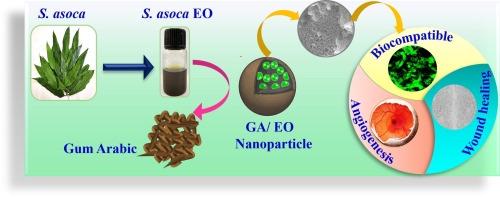Green synthesized gum Arabic nano-biopolymer encapsulating Saraca asoca leaf essential oil accelerates wound healing
IF 9.2
2区 工程技术
Q1 ENERGY & FUELS
引用次数: 0
Abstract
Plant essential oils (EO) has demonstrated remarkable bio-efficacies throughout. Yet, they are highly prone to environmental stimuli leading to their degradation. Nanoencapsulation has blossomed as a promising technology to preserve the inherent bioactivities of the EOs. Thus, in this study, EO of Saraca asoca leaves have been encapsulated in gum Arabic (GA) biopolymer. The leaf EO was accomplished by the ultrasound-assisted hydrodistillation method. The synthesis of nano-GA and EO-encapsulated GA nanoparticles was followed via the green route using A. marmelos leaf extract. The pristine GA nanoparticles demonstrated a mean diameter of 175.2 nm which further increased with increase in EO content. The encapsulation of EO onto the GA nanoparticles slightly enhanced their thermal stability. The in vitro EO release profiles in SGF and SIF accorded to colonic delivery. The GA nanoparticles effectually preserved the TPC and TFC of the encapsulated S. asoca leaf EO. The antioxidant activity of encapsulated EO in terms of DPPH and superoxide radical scavenging was found to be higher than the pure EO. The samples exhibited good antibacterial and antiobiofilm activities against E. coli and E. faecalis. The scratch assay on 3 T3 cells revealed the wound closure was prominent in GA/ EO1:1 with cellular migration of 90 % in 48 h. The in vivo CAM assay also pointed to the fast angiogenesis and neovascularization occurring in GA/ EO1:1 in 48 h, thus highly recommending its applicability in wound healing. Furthermore, the effective skin irritation index zero confirms GA/ EO1:1 as a safe candidate for transdermal application.

绿色合成阿拉伯树胶纳米生物聚合物包封沙拉果叶精油加速伤口愈合
植物精油(EO)一直以来都显示出显著的生物功效。然而,它们极易受到环境刺激而导致退化。纳米胶囊化作为一种很有前途的技术,已成为保存EOs固有生物活性的一种技术。因此,本研究将阿拉伯胶(GA)生物聚合物包埋在沙牛蒡叶的EO中。采用超声辅助加氢蒸馏法对叶片进行气相萃取。以柑桔叶提取物为原料,通过绿色途径合成纳米赤霉素及其包封的赤霉素纳米颗粒。原始GA纳米颗粒的平均直径为175.2 nm,随着EO含量的增加,纳米颗粒的直径进一步增大。将环氧乙烷包埋在纳米颗粒上,可以略微提高纳米颗粒的热稳定性。体外EO在SGF和SIF中的释放符合结肠释放。GA纳米颗粒能有效地保存被包封的山茱萸叶的TPC和TFC。结果表明,包封的环氧乙烷在DPPH和清除超氧自由基方面的抗氧化活性高于纯环氧乙烷。样品对大肠杆菌和粪肠杆菌具有良好的抗菌和抗膜活性。对3个T3细胞的划痕实验显示,GA/ EO1:1的伤口愈合明显,在48小时内细胞迁移率达到90%。体内CAM实验也表明,GA/ EO1:1在48小时内血管生成和新生血管快速形成,因此高度推荐其在伤口愈合中的适用性。此外,有效的皮肤刺激指数为零,证实GA/ EO1:1是透皮应用的安全候选物。
本文章由计算机程序翻译,如有差异,请以英文原文为准。
求助全文
约1分钟内获得全文
求助全文
来源期刊

Sustainable Materials and Technologies
Energy-Renewable Energy, Sustainability and the Environment
CiteScore
13.40
自引率
4.20%
发文量
158
审稿时长
45 days
期刊介绍:
Sustainable Materials and Technologies (SM&T), an international, cross-disciplinary, fully open access journal published by Elsevier, focuses on original full-length research articles and reviews. It covers applied or fundamental science of nano-, micro-, meso-, and macro-scale aspects of materials and technologies for sustainable development. SM&T gives special attention to contributions that bridge the knowledge gap between materials and system designs.
 求助内容:
求助内容: 应助结果提醒方式:
应助结果提醒方式:


